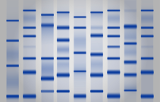Electrophoresis is a fundamental technique in molecular biology, enabling the separation and analysis of biomolecules such as DNA and RNA based on their size, charge, and shape. Electrophoresis leverages the movement of charged molecules under the influence of an electric field. Molecules migrate toward oppositely charged electrodes—positively charged molecules (cations) move toward the cathode, while negatively charged molecules (anions) move toward the anode. The separation occurs within a matrix, such as a gel or solution, which acts as a medium to facilitate molecular migration and separation.
Applications in Molecular Biology
Electrophoresis is indispensable for studying nucleic acids with applications ranging from basic research to biotechnology:
- DNA Fragmentation Analysis: Agarose gel electrophoresis is frequently used to analyze DNA fragments after enzymatic digestion or PCR amplification. This allows for the visualization of the size and quantity of DNA fragments, which is crucial for applications like cloning, restriction digestion, and PCR verification.
- RNA Integrity Assessment: Electrophoresis is used extensively in transcriptomic studies to assess the integrity of RNA. This is essential when preparing samples for RNA sequencing or microarray analysis. Degraded RNA can significantly affect the quality of results, and electrophoresis offers a quick and reliable method for quality control.
- Genetic Screening and Mutation Detection: Electrophoretic techniques, such as single-strand conformation polymorphism (SSCP) or denaturing gradient gel electrophoresis (DGGE), are used in genetic screening to detect mutations in DNA sequences. These techniques help identify polymorphisms or mutations that may be linked to genetic diseases or conditions.
Electrophoresis remains a cornerstone technique in molecular biology due to its versatility and precision. It provides essential insights into biomolecular properties. As technological advancements continue to refine electrophoretic methods, their applications will expand further into diagnostics, therapeutics, and environmental science.






